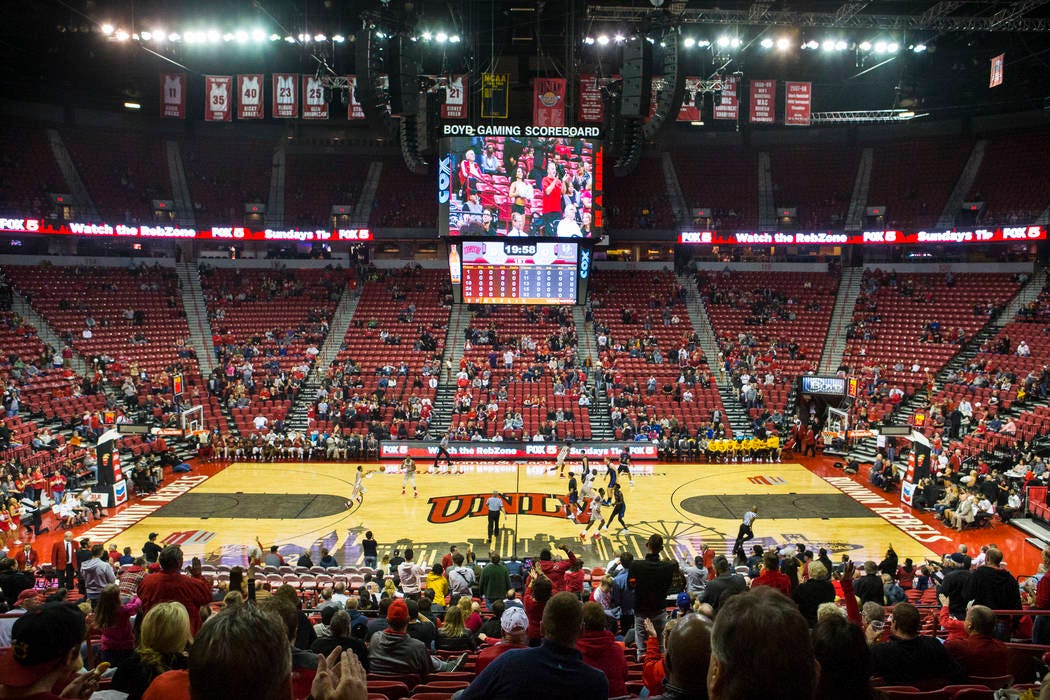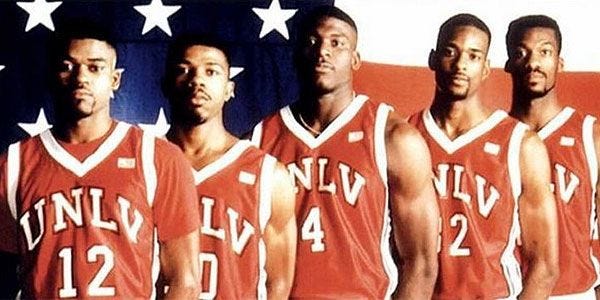Where does UNLV fit in modern college basketball and in a very different Las Vegas?
The sport and even the Rebels' hometown have changed dramatically since the program was last a national powerhouse. Can it ever get back there?
Last Saturday, work was underway for something that Las Vegas is quite good at – throwing a party.
With Super Bowl LVIII just eight days away, preparations continued for the city to host the most popular and ubiquitous event on the American sports calendar. The Super Bowl isn’t just a game. It’s a festival and larger celebration, one that engulfs cities, bringing hundreds of thousands of visitors to them and all the disposable income they’re willing to part with. It’s the kind of metaphorical carrot that compels franchises and, often, their city’s taxpayers to pump hundreds of millions of dollars into stadium improvements or more than $1 billion into building an opulent new venue entirely.
But in the days before the football world descended on Las Vegas, there was another sporting event in town.
Three miles to the east of Allegiant Stadium, where the Kansas City Chiefs and San Francisco 49ers will fight for the NFL’s most coveted prize Sunday, 5,963 people gathered inside the Thomas & Mack Center to watch UNLV beat Wyoming 62-48.
The victory was the Rebels’ third in a row, helping them improve to 12-9 in their third season under coach Kevin Kruger. The scene around that triumph, however, was telling. As Las Vegas prepared to showcase itself to the broader athletic world, a team that was once the city’s preeminent athletic attraction toiled away in the shadows of an arena that was one-third full.
Of all the ways Las Vegas’ aggressive growth over the past several decades can be quantified, few illustrate it quite as effectively and succinctly as its emergence as a market for major professional sports. Sin City is now home to the NHL’s Golden Knights and the NFL’s Raiders, with the MLB’s Oakland Athletics probably (maybe?) on the way.
As that occurs, though, the championship-winning men’s basketball program at its biggest university has fallen on hard times. UNLV once competed for national titles, but is now a middle-of-the-road team in its own conference, one that regularly plays in front of sparse crowds of fans who are further and further removed from the Rebels’ glory days.
It’s a decline that has raised an uncomfortable and still unanswered question – what does a former college basketball juggernaut mean not only in its sport, but its own city?
How UNLV basketball rose from nothing to something
That UNLV was ever a major force in a tradition-soaked sport like college basketball remains a marvel. Much like the city it calls home, it sprung up from virtually nowhere.
Established in 1957, the university wasn’t even known by its present name until 1969, though even then, it was often referred to derisively as “Tumbleweed Tech.”
By the mid-1970s, however, that national perception began to change. In 1973, 43-year-old Jerry Tarkanian, the son of Armenian immigrants, was hired as the head coach of the school’s men’s basketball program, which had begun Division I competition just four years earlier. Tarkanian quickly built the Rebels into a contender, winning 20 games his first season and guiding them to the Sweet 16 in his second season. By his fourth season, UNLV crashed the Final Four.
That success continued. For 10 consecutive years, from 1983-92, the Rebels finished ranked in the top 15 nationally. During that stretch they made three more Final Fours and in 1990, they won the national championship, walloping Duke 103-73 in what’s still the most lopsided title game in the history of the event.
It wasn’t just that UNLV won, but how it won. Tarkanian implemented an up-tempo style that was predicated on fast-break opportunities caused by the coach’s trademark amoeba defense, an aggressive zone scheme that sought to force steals and get the team out in transition. In the process, they ceased to be just the Rebels – they were the Runnin’ Rebels. True to their name, they were regularly among the highest-scoring teams in the country and took part in some of the most exciting, frenetic college basketball games you’ll see in any era, like their 112-105 win at Arkansas in 1991 in a matchup of the nation’s Nos. 1 and 2 teams.
UNLV consistently churned out NBA prospects, a number of whom were overlooked or undervalued when they were first brought aboard by Tarkanian – players like Larry Johnson, Reggie Theus, Armen Gilliam, Stacey Augmon and Greg Anthony.
The Rebels were perhaps just as much of a force off the court than they were on it.
Keep reading with a 7-day free trial
Subscribe to The Front Porch to keep reading this post and get 7 days of free access to the full post archives.





